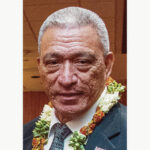Plan to ban 7,000 Maui short-term rentals targets resort condos



A luxury apartment-hotel, a $4 million beach house and condominiums at a resort golf course don’t typically constitute workforce housing in Hawaii, but they are targets of a plan on Maui aimed at converting short-term vacation rental properties to long-term housing for residents.
The Maui Planning Commission on Tuesday is scheduled to kick off the multilayered regulatory review of Maui County Mayor Richard Bissen’s proposal to phase out currently legal short-term rental use of roughly 7,000 units in apartment-zoned districts on Maui and Molokai, including about 2,200 units in West Maui.
Considerable debate is expected over the highly charged proposal, which was prompted largely by the loss of around 3,500 homes in the Aug. 8 Lahaina wildfire.
Bissen has described his proposal as a move to revert the 2,200 West Maui units to workforce housing, which he said is what most or all of the these units were originally designed and built to be.
“Our goal is to return them to their intended purpose,” he said during a May 2 presentation announcing the plan.
However, an analysis of all the units slated for conversion in West Maui under Bissen’s proposal shows that most of them were originally condominiums developed for resort use.
Representatives of the mayor were not able last week to identify properties to be converted that were developed as workforce housing.
Property mix
West Maui properties targeted for conversion include:
• Three condo projects at Kaanapali Beach Resort with a combined 568 units, including the oceanfront 258-unit Hale Kaanapali which is now known as the Aston Maui Kaanapali Villas. But it opened in 1967 as the Hilton Hale Kaanapali just ahead of units being sold individually as part of a luxury apartment-hotel that its developer said would become “the Kahala Hilton of Kaanapali.”
• Three condo projects at Kapalua Resort — Bay Villas, Golf Villas and The Ridge — with a combined 488 units that sold out as part of the resort’s initial development in the mid-1970s.
• Papakea, a 364-unit beachfront condo complex in Kaanapali that is the biggest single project intended for conversion in West Maui and was originally marketed for sale to first- and second-home buyers before it was completed in 1977.
There are also about 860 units among roughly 20 properties in the Napili-Honokowai area between Kaanapali and Kapalua. The biggest one of these is the 100-unit Kuleana II, where units were marketed for sale as a resort condo investment opportunity in 1972 and came with vacation exchange privileges under a program called Club Mondiale.
Outside West Maui, properties targeted for conversion include six projects with 782 units at Wailea Resort in South Maui, 479 units at eight projects in Maalaea, the 30-unit Kuau Plaza in Paia, and a 19-unit property in Hana called Hana Kai-Maui.
There are also two projects on Molokai, the 120-unit Ke Nani Kai condo completed in 1983 as part of Kaluakoi Resort, and the 126-unit Wavecrest condo developed in 1975 and initially sold mostly to Hawaii residents who wanted to “get away” to Molokai.
Most properties on the conversion list are in Kihei, where about 3,000 units are divided among about 50 properties.
Among the Kihei properties are a few single-family homes, including the beachfront Indo Lotus Beach House built in 1970 and valued for property tax purposes at $4.2 million.
The single biggest property on the entire conversion list also is in Kihei: The 440-unit Kamaole Sands was built in 1983 as a resort condo described at the time as the largest such property in Hawaii offering fully equipped kitchens, extensive guest activities and daily maid service.
Many of these same projects have been described by supporters of the conversion plan as apartment housing that was bought up by outside investors who displaced local families by renting the units to vacationers.
Ricky Cassiday, a local housing market researcher and consultant, said many of the properties targeted for conversion were produced to capitalize on booming tourism 50 or 60 years ago with less financial risk than traditional hotel development because condo units for resort use could be sold to individual buyers before construction.
At the time, condo-hotel projects were permitted under apartment district zoning on Maui.
Amending ordinances
According to Bissen’s proposed legislation, Maui County Code didn’t clearly define transient vacation rental use until an ordinance was established in 1980 that defined the term as rentals for less than 30 days in multiunit buildings. Even then, transient vacation rentals could still be built in apartment and hotel districts.
Maui County enacted another ordinance in 1989 to no longer permit vacation rentals in areas with apartment zoning, but recognized that this change would not apply to properties that received development approvals before 1989.
Such “grandfathered” properties became lawful nonconforming uses on what became known as the Minatoya List after then-Deputy Corporation Counsel Richard Minatoya, who authored a legal opinion on the nonconforming-use recognition.
Now, Bissen’s proposed legislation seeks to “un-grandfather” the roughly 7,000 Minatoya List properties.
“Apartment Districts are, among other things, intended to provide higher density, long-term housing to residents,” the draft legislation states. “The purpose of this ordinance is to revert all Apartment District properties to their intended long-term residential use.”
Backing for such an ordinance was provided by state lawmakers this year through Senate Bill 2919, which states that transient accommodations may be phased out in any zoning district by county zoning regulations. SB 2919 was signed into law by Gov. Josh Green on May 3.
Under Bissen’s draft ordinance, legal short-term rental use in apartment districts would be terminated July 1, 2025, in West Maui, and Jan. 1, 2026, for the rest of Maui County.
Challenges ahead
Cassiday said it is conceivable that Minatoya List properties could become part of Maui’s workforce housing inventory if the legislation passes, but not without difficulty.
For one, there almost certainly will be litigation over the county canceling a longtime lawful real estate use, which opponents of the legislation have said runs afoul of the U.S. Constitution unless the county compensates property owners for the loss.
Such litigation could take years to resolve, and Bissen, a former judge, anticipates the legal challenge.
If that hurdle is overcome, units on the Minatoya List could become used as primary or secondary residences by existing owners, subsequent buyers or as long-term rentals that increase Maui’s housing supply for residents. But to what extent sale or rental prices come down is hard to predict.
Sale prices since 2023 for units at the three Kapalua Resort projects on the list have mainly ranged from around $1 million to $3 million. At the three Kaanapali Resort projects, the range is mainly from $650,000 to $2 million but less for leasehold units at one of them, the Maui Eldorado.
According to the Council for Native Hawaiian Advancement, the median assessed value for all Minatoya List properties is $954,450. That means half are assessed for more than that figure and half for less.
Maintenance fees can be over $1,000 a month for some of the priciest units at Minatoya List projects.
Cassiday said it’s questionable how much workforce housing will be added if the conversion is successful, but that negative impacts on county tax revenue, the tourism industry and the economy generally are certain.
“I think overall it will be detrimental to the general public,” he said.
Still, supporters vow to push ahead with the legislation in defense of Maui residents amid a housing shortage and condo owners benefiting from the visitor industry.
“This bill sets out to accomplish the clear objective of prioritizing housing opportunities for our residents over the interests of offshore investors,” Maui County Council member Keani Rawlins-Fernandez said at the May 2 presentation. “We will see this all the way through.”
The draft legislation is to be considered by the county’s different island planning commissions and then later by the County Council.







